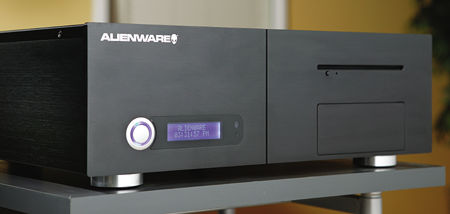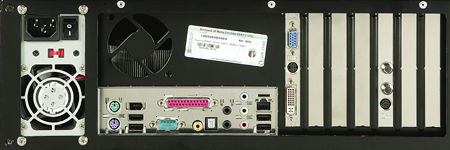Alienware DHS-321 PC
Savvy readers might be familiar with Alienware. Their built-to-order gaming PCs are as famous as their functional and distinctive cases that prevent dust and birds from nesting between the circuit boards. Taking those two strengths into the living room, Alienware has introduced a Media Center Edition PC like no other, the DHS-321 Digital Home System. This box, which approximates the look of a consumer electronics component in black-anodized, brushed aluminum, runs the Microsoft Windows XP Media Center Edition 2004 operating system.
Under the Hood

The DHS-321 boasts a 3-gigahertz Intel Pentium 4 processor and an on-motherboard SoundMAX audio solution that provides Dolby Digital processing, 20-bit audio, and digital optical and coaxial audio outputs; 5.1-channel analog audio outputs are also available via three stereo mini-jacks. The ATI Radeon 9800 Pro 256-megabyte graphics card ensures that this is a killer gaming box. You also get the ATI EHOME Wonder TV cable/antenna television tuner, a 250-gigabyte Western Digital hard drive spinning at 7,200 revolutions per minute, and the Panasonic UJ825B 4X DVD-R/-RW/+R/+RW/-RAM recorder. Preloaded entertainment software includes a basic version of Cyberlink PowerDVD (prepare to be e-pitched for upgrades) and the ever-handy Nero Burning ROM optical disc recording software (cleverly named as a play on the expression "Nero fiddled while ROMe burned").
While only an AC power cable is included, this PC is composite-, S-video-, and DVI-ready right out of the carton, and it also works with component video (interlaced or progressive) if you use the optional ATI DVI-to-Y/Pb/Pr adapter plug. Physically, the video and digital audio connections were remarkably simple, but mini-plug-to-RCA adapters would also be handy—one for stereo, three for 5.1—but not entirely necessary if you connect the PC to a well-featured receiver or preamp. A custom Alienware manual is provided, with abbreviated instructions to have users up and running as quickly as possible.
Just Because It Looks Like Home Theater Gear. . .
While fairly extensive calibration tools are offered right on the hard drive as part of the Windows Media Center Edition setup package—allowing me to specify my non-CRT rear-projection TV, with helpful demo material at the ready—Microsoft's onscreen instructions kept referring me to controls that didn't exist on my TV remote, so fine-tuning image size and position was ultimately impossible. To be fair, this was a frustration born of the operating system and not the hardware, and Alienware informs me that major OS updates are coming. Proper configuration also demands at least a temporary hookup of the Gyration mouse and keyboard. The easiest peripheral to add was my Linksys WUSB54G Wireless-G USB network adapter, for quick/simple Internet access, after a lightning-fast driver install from the CD-ROM.

The first 20 seconds of boot-up were violently distorted before the PC acknowledged my component video connection's progressive output. It took another 15 seconds for the famous "10-foot interface" to appear on the TV, clearly visible across the room.
I wasted no time popping in Finding Nemo. While the Alienware remote makes control similar to that of a living-room device, the picture was softer than that from my go-to DVD deck, and loading required a few extra seconds. CD playback was fine but in no way spectacular, while MP3s sounded somewhat flatter than they do through a good portable. The PC reproduced the Dolby Digital 5.1 track on the Donald Fagen Nightfly DVD-Audio cleanly—no more, no less.
The DHS-321's DVR functionality is straightforward, with a direct connection to a raw cable feed or a more-elaborate IR blaster (supplied) connection to a cable or satellite set-top box. However, Windows MCE couldn't provide program-guide data for my town, despite multiple attempts.
Let's See Your PC Do This
Discs load to the DHS-321's single drive via a slender slot, not a tray—another of the sleek unit's vanities. The most significant design feature is the inclusion of a unique LCD InfoPanel that liberates this PC by showing such useful tidbits as song title and artist, DVD title and chapter info (as available), and the names of digital photos, right on the unit's face. When not otherwise engaged, the panel displays the current time, down to the second.
 Actual CD use was a tad more involved: Discs begin playing automatically after a few seconds, but the DHS-321 doesn't disclose album and track names unless you actively request the disc information, using onscreen menus. If you switch on the TV while listening to music, you're treated to cover art from the Internet and other options, such as ripping (it copied and compressed a 75-minute CD in less than five minutes—while playing it), serving up live graphic accompaniment, and e-commerce.
Actual CD use was a tad more involved: Discs begin playing automatically after a few seconds, but the DHS-321 doesn't disclose album and track names unless you actively request the disc information, using onscreen menus. If you switch on the TV while listening to music, you're treated to cover art from the Internet and other options, such as ripping (it copied and compressed a 75-minute CD in less than five minutes—while playing it), serving up live graphic accompaniment, and e-commerce.
I had to close Windows MCE and revert to the backup Windows XP Pro OS in order to play tracks from a connected portable (via the wonderful front-panel conglomeration of ports, jacks, and slots, all behind a flip-down door) or a CD full of MP3s, as the custom entertainment interface did nothing with them.
How to judge the DHS-321, as a computer or as a home theater component? The 270-watt power supply is certainly quiet by PC standards, but this was the noisiest piece of gear in my home theater during the review process, with its omnipresent "always on" operation. Although the device's versatility, power, upgradeability, and convenience are unmatched in the CE realm, mid-level A/V gear delivers superior picture and sound quality, and the current iteration of Windows XP Media Center Edition still isn't the truly elegant solution that Microsoft has been bragging about. Bill Gates and the gang, frankly, need to catch up to the design and hardware experts at Alienware at this point.
Highlights
• Sized and styled like a (big) home theater component, with a remote control
• All of the PC versatility we rely on
• The OS can bog you down
Review
- Log in or register to post comments




































































